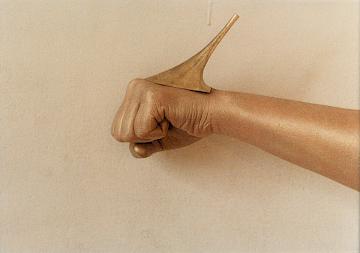Revolution from Within
In her book Revolution from Within (1992), feminist writer Gloria Steinem takes an approach that is considerably different from that of her beginnings. She speaks of self-esteem, meditation, and of channeling one’s “inner child”; what’s more, she seems just as concerned with men’s well-being as with women’s. The choice of the book’s title as a reference for this exhibition of twelve female artists (who vary greatly in age and geographical provenance) expresses a particular position with regard to feminist art: perhaps not “post-feminist” but one that certainly belongs to a flexible understanding of the word, which, as the press release notes, evolves, is complex, and allows for a coexistence of “categories that, on the surface, appear irreconcilable: feminism and femininity, the political sphere and an aesthetic one, the domestic and collective space.”
“Revolution from Within” develops these premises in a coherent fashion: Classic themes of feminist art are not absent, but they are revisited in sometimes surprising ways, as, for example, with that trope of tropes, the representation of the female body. If Birgit Jürgenssen’s work from the 1970s, on view here, deals with it relatively canonically, through photographic self-portraits that are Surrealist in inspiration—Untitled (Improvisation) (ph1541) , 1976, for example, has a stiletto heel sprouting out of young woman’s arm—the younger artists either seem uninterested in the subject of the body and its representation or address it obliquely. In Nothing Is Enough, 2012, Frances Stark stages her own sexual life with a video detailing an erotic conversation she had in an online chat room with a stranger—there are no images, just lines of text projected against a neutral background. In a similar vein, glossy images by Anne Collier evoke female identity through metonym and clues: Take the photograph Valerie, 2011, which features a pile of editions of the 1967 polemic SCUM Manifesto by the militant feminist Valerie Solanas—a text that called for the “elimination of men” and whose author was famously called the “Robespierre of feminism”—shot against an icy white background. The only two explicit nudes on view are both male (Goshka Macuga’s retro collages of bodybuilders). mehr
, 1976, for example, has a stiletto heel sprouting out of young woman’s arm—the younger artists either seem uninterested in the subject of the body and its representation or address it obliquely. In Nothing Is Enough, 2012, Frances Stark stages her own sexual life with a video detailing an erotic conversation she had in an online chat room with a stranger—there are no images, just lines of text projected against a neutral background. In a similar vein, glossy images by Anne Collier evoke female identity through metonym and clues: Take the photograph Valerie, 2011, which features a pile of editions of the 1967 polemic SCUM Manifesto by the militant feminist Valerie Solanas—a text that called for the “elimination of men” and whose author was famously called the “Robespierre of feminism”—shot against an icy white background. The only two explicit nudes on view are both male (Goshka Macuga’s retro collages of bodybuilders). mehr
In addition to the aforementioned artists, the exhibition, notable for its breadth, includes work by Ketuta Alexi-Meskhishvili, Lutz Bacher, Andrea Bowers, Nina Canell, Marieta Chirulescu, Lucy Dodd, Yayoi Kusama, and Maria Loboda. In this tightly curated lineup, most of these artists forgo the explicit in favor of the freedom that comes with the implicit, approaching feminism with enough nuance and tenacity that it takes on new resonance.
Translated from Italian by Marguerite Shore.